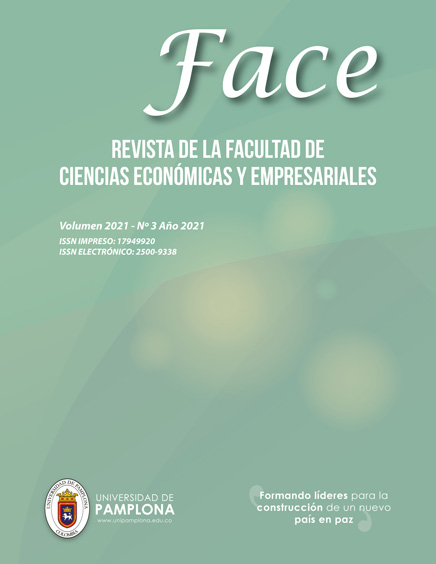EFFECTS OF REGIONAL CERTIFICATION ON EXPORT ACTIVITY, THE CASE OF THE MEXICAN LEATHER-FOOTWEAR CLUSTER
DOI:
https://doi.org/10.24054/face.v21i3.1134Resumen
La Marca Gto is a program created in Mexico in 2015 that looks for the creation of a good quality reputation of the
products that receive it as a certification or regional trademark label. The objective of this research is to find an
association between the participation of Mexicans MSMEs in this program and the beginning of export activity. A survey
of 21 questions was applied to 69 SMEs that currently have this certification. The sample of this study is part of the
Leather-Footwear Cluster of Guanajuato since this is one of the most traditional of the State that thorough the recent
years has registered a decreasing volume of exports. The IBM SPSS Program was used to analyze the collected data
and by applying McNemar test there was not found any association between the Marca Gto Certification and the
beginning of export activity of the company.
Descargas
Referencias
Aerd Statistics (October 25th, 2020). McNemar's test using SPSS Statistics. Aerd Statistics https://statistics.laerd.com/spss-tutorials/mcnemars-test-using-spss-statistics.php
Ávila, A. (October 20th, 2020).Ciceg prevé caída del 25 por ciento en el sector cuero calzado por pandemia. Zona Franca. https://zonafranca.mx/politica-sociedad/economia/ciceg-preve-caida-del-25-por-ciento-en-el-sector-cuero-calzado-por-la-pandemia/
Becattini, G. (1989). Sectors and/or districts: some remarks on the conceptual foundations of industrial economics. In: E. Goodman & J. Bamford (Eds.), Small firms and industrial districts in Italy. Routledge.
Becattini, G. (1990). The Marshallian industrial district as a socioeconomic notion. In: F. Pyke,
O. Becattini & W. Sengenberger (Eds.), Industrial districts and inter-firm cooperation in Italy.International Institute for Labour Studies, Geneva.
China Footwear Information Network, (2007). Wenzhou Xieye Ershi Nian Dashi Ji. <http://www.shoelib.com/xwh/xyjs/200709/t20070920_44179.html>.
Chugan, P. K. & Singh, S. (2014). Taxonomy for firm-level determinants of export performance.
Universal Journal of Industrial and Business Management, 2(1), 6-12. doi:10.13189/ujibm.2014.020102
Coordinadora de Fomento al Comercio Exterior del Estado de Guanajuato (2020). Cartera Económica COFOCE primer semestre 2020. https://cofoce.guanajuato.gob.mx/wp-content/uploads/2020/08/CARTERA-ECONOMICA_COFOCE_JUNIO-2020.pdf
Diez-Vial, I. & Fernández-Olmos, M. (2014). Moderating influence of internal resources on clusterexternalities. EuroMed Journal of Business, 9(1), 75-92. doi:10.1108/EMJB-04-2013-0014
Fernhaber, S. A., Gilbert, B. A. & McDougall, P. P. (2008).
International entrepreneurship andgeographic location: an empirical examination of new venture internationalization. Journal ofInternational Business Studies, 39(2), 267-290. doi: 10.1057/palgrave.jibs.8400342
Gobierno del Estado de Guanajuato (November 20th, 2019). Entregan el Distintivo Marca GTO número 2 mil. Gobierno del Estado de Guanajuato. https://boletines.guanajuato.gob.mx/2019/11/20/entregan-el-distintivo-marca-gto-numero-2-mil/
Hashino, T. & Otsuka, K. (2016). Chapter 1 Beyond Marshallian Agglomeration Economies in T. Hashino & K. Otsuka Ed., Industrial Districts in History and the Developing World (pp. 3-13). Springer.
Huang, Z., Zhang, X. & Zhu, Y. (2008) The role of clustering in rural industrialization: a case study of Wenzhou’s Footwear Industry. China Econ Rev19(3), 409–420.
Kiosco de la Historia (October 10th, 2020). ¿Qué es la Marca Gto?KH Kiosco de la historia.https://www.kioscodelahistoria.com/marca-gto
Li, J. (2006). Kankan Renjia Wenzhouren. Jinghua Press.
McNemar, Q. (1947). Note on the sampling error of the difference between correlated proportions or percentages.Psychometrika,12(2), 153–157.
Marshall, A. (1920). Principles of Economics, 8th Ed. Macmillan.
Miranda, A. (2019, March 14th). Cifras de la industria cuero-calzado Guanajuato 2019. Unión Guanajuato. https://www.unionguanajuato.mx/articulo/2019/03/14/empresas/cifras-de-la-industria-cuero-calzado-guanajuato-2019
Moghaddam, F. M., Hamid, A. B. B. A., & Aliakbar, E. (2012). Management influence on the export performance of firms: a review of the empirical literature 1989-2009. African Journal of Business Management, 6(15), 5150-5158. doi: 10.5897/AJBM11.1408
Nazar, M. S., & Saleem, H. M. N. (2009). Firm-level determinants of export performance. International Business & Economics Research Journal, 8(2), 105-112. doi:10.19030/iber.v8i2.3107
Ortiz, A., & Martínez, A. (2000). Factores de competitividad, situación nacional y cadena productiva de la industria del calzado de Leon, Guanajuato. Economía, Sociedad y Territorio, 2(7), 533-568.
Periódico Oficial del Estado de Guanajuato (December 31st, 2019). https://www.ciceg.org/pdf/RO_2020.pdf
Prim, A. L., Amal, M. & Carvalho, L. (2016). Regional Cluster, Innovation and Export Performance: An Empirical Study. Brazilian Administration Review, 13 (2), 1-26. http://dx.doi.org/10.1590/1807-7692bar2016160028
Ruan, J. & Xiaobo, Z. (2018). Low-Quality Crisis and Quality Improvement: The Case of Industrial Clusters in Zhejiang Province. In T. Hashino & K. Otsuka (Eds.), Industrial Districts in History and the Developing World(pp. 169-190). Springer.
Ruiz, J. (October 6th, 2020). Se han perdido 15 mil empleos del sector cuero-calzado en Guanajuato. Milenio. https://www.milenio.com/politica/comunidad/perdido-15-mil-empleos-sector-cuero-calzado-guanajuato
Secretaría de Desarrollo Económico Sustentable del Estado de Guanajuato (October 1st, 2020). Objetivos Marca Gto. Marca Gto. https://marcaguanajuato.mx/
Schmitz, H. & Musyck, B. (2016). Industrial Districts in Europe: Policy Lessons for Developing Countries? In T. Hashino & K. Otsuka (Eds.), Industrial Districts in History and the Developing World (pp. 117-152). Springer.
Sengenberger, W. & Pyke, F. (1992). Industrial districts and local economic regeneration: Research and policy issues. In: F. Pyke & W. Sengenberger (Eds.), Industrial districts and local Economic
Regeneration. International Institute for Labour Studies.
Srivastava, M., Moser, R. & Meijer, T. de (2015). Internationalization and performance in European market: an Asian perspective. International Business Research, 8(4), 122-138. doi:10.5539/ibr.v8n4p122
Staritz, C., Plank, L. & Morris, M. (2016). Global Value Chains, Industrial Policy, and Sustainable
Development –Ethiopia’s Apparel Export Sector. Geneva: International Centre for Trade andSustainable Development (ICTSD).
Tetsushi, T., Otsuka, K. & Hashino, T. (2018). Toward a New Paradigm of the Long-Term
Development of Industrial Districts. In T. Hashino & K. Otsuka (Eds.),Industrial Districts in History and the Developing World (pp. 13-24). Springer.
University of California Los Ángeles (October 25th, 2020). What does Cronbach’s alpha mean? Institute for Digital research & Education, Statistical Consultingresearchhttps://stats.idre.ucla.edu/spss/faq/what-does-cronbachs-alpha-mean/
Yadav, D. S. & Chaturvedi, V. (2018). A Study on Factors Affecting Exports of Leather Footwear as a Strong Initiative of Make In India: Opportunities And Challenges. Amity Journal of Management 6 (2), 38-45.
Yuya Ahmad, A. & Tufa Adineu, M. (2018). Evaluating the impact of export promotion policy incentives in the Ethiopian manufacturing sector. Competitive Industries and Innovation Program CIIP, 1-42.
Descargas
Publicado
Versiones
Número
Sección
Licencia
Derechos de autor 2022 FACE: Revista de la Facultad de Ciencias Económicas y Empresariales

Esta obra está bajo una licencia internacional Creative Commons Atribución-NoComercial-CompartirIgual 4.0.





